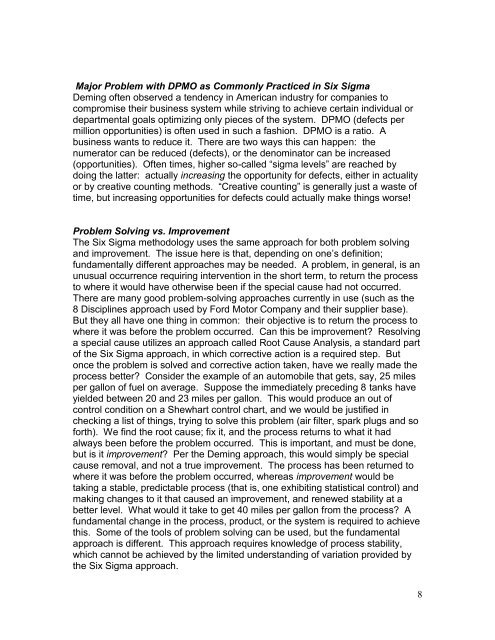Six Sigma, Through The Lens Of Dr. Deming's Philosophy And
Six Sigma, Through The Lens Of Dr. Deming's Philosophy And
Six Sigma, Through The Lens Of Dr. Deming's Philosophy And
You also want an ePaper? Increase the reach of your titles
YUMPU automatically turns print PDFs into web optimized ePapers that Google loves.
Major Problem with DPMO as Commonly Practiced in <strong>Six</strong> <strong>Sigma</strong><br />
Deming often observed a tendency in American industry for companies to<br />
compromise their business system while striving to achieve certain individual or<br />
departmental goals optimizing only pieces of the system. DPMO (defects per<br />
million opportunities) is often used in such a fashion. DPMO is a ratio. A<br />
business wants to reduce it. <strong>The</strong>re are two ways this can happen: the<br />
numerator can be reduced (defects), or the denominator can be increased<br />
(opportunities). <strong>Of</strong>ten times, higher so-called “sigma levels” are reached by<br />
doing the latter: actually increasing the opportunity for defects, either in actuality<br />
or by creative counting methods. “Creative counting” is generally just a waste of<br />
time, but increasing opportunities for defects could actually make things worse!<br />
Problem Solving vs. Improvement<br />
<strong>The</strong> <strong>Six</strong> <strong>Sigma</strong> methodology uses the same approach for both problem solving<br />
and improvement. <strong>The</strong> issue here is that, depending on one’s definition;<br />
fundamentally different approaches may be needed. A problem, in general, is an<br />
unusual occurrence requiring intervention in the short term, to return the process<br />
to where it would have otherwise been if the special cause had not occurred.<br />
<strong>The</strong>re are many good problem-solving approaches currently in use (such as the<br />
8 Disciplines approach used by Ford Motor Company and their supplier base).<br />
But they all have one thing in common: their objective is to return the process to<br />
where it was before the problem occurred. Can this be improvement? Resolving<br />
a special cause utilizes an approach called Root Cause Analysis, a standard part<br />
of the <strong>Six</strong> <strong>Sigma</strong> approach, in which corrective action is a required step. But<br />
once the problem is solved and corrective action taken, have we really made the<br />
process better? Consider the example of an automobile that gets, say, 25 miles<br />
per gallon of fuel on average. Suppose the immediately preceding 8 tanks have<br />
yielded between 20 and 23 miles per gallon. This would produce an out of<br />
control condition on a Shewhart control chart, and we would be justified in<br />
checking a list of things, trying to solve this problem (air filter, spark plugs and so<br />
forth). We find the root cause; fix it, and the process returns to what it had<br />
always been before the problem occurred. This is important, and must be done,<br />
but is it improvement? Per the Deming approach, this would simply be special<br />
cause removal, and not a true improvement. <strong>The</strong> process has been returned to<br />
where it was before the problem occurred, whereas improvement would be<br />
taking a stable, predictable process (that is, one exhibiting statistical control) and<br />
making changes to it that caused an improvement, and renewed stability at a<br />
better level. What would it take to get 40 miles per gallon from the process? A<br />
fundamental change in the process, product, or the system is required to achieve<br />
this. Some of the tools of problem solving can be used, but the fundamental<br />
approach is different. This approach requires knowledge of process stability,<br />
which cannot be achieved by the limited understanding of variation provided by<br />
the <strong>Six</strong> <strong>Sigma</strong> approach.<br />
8



